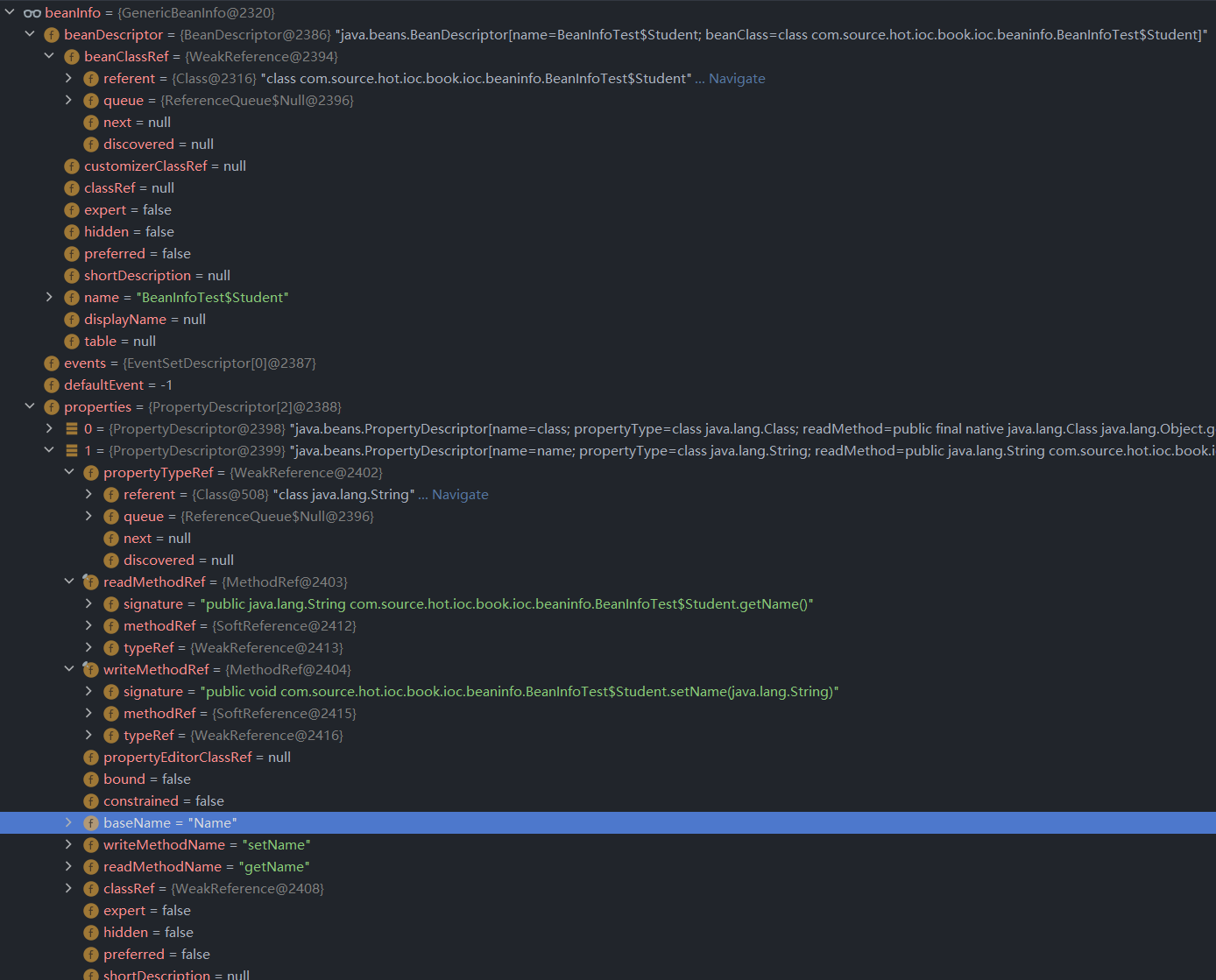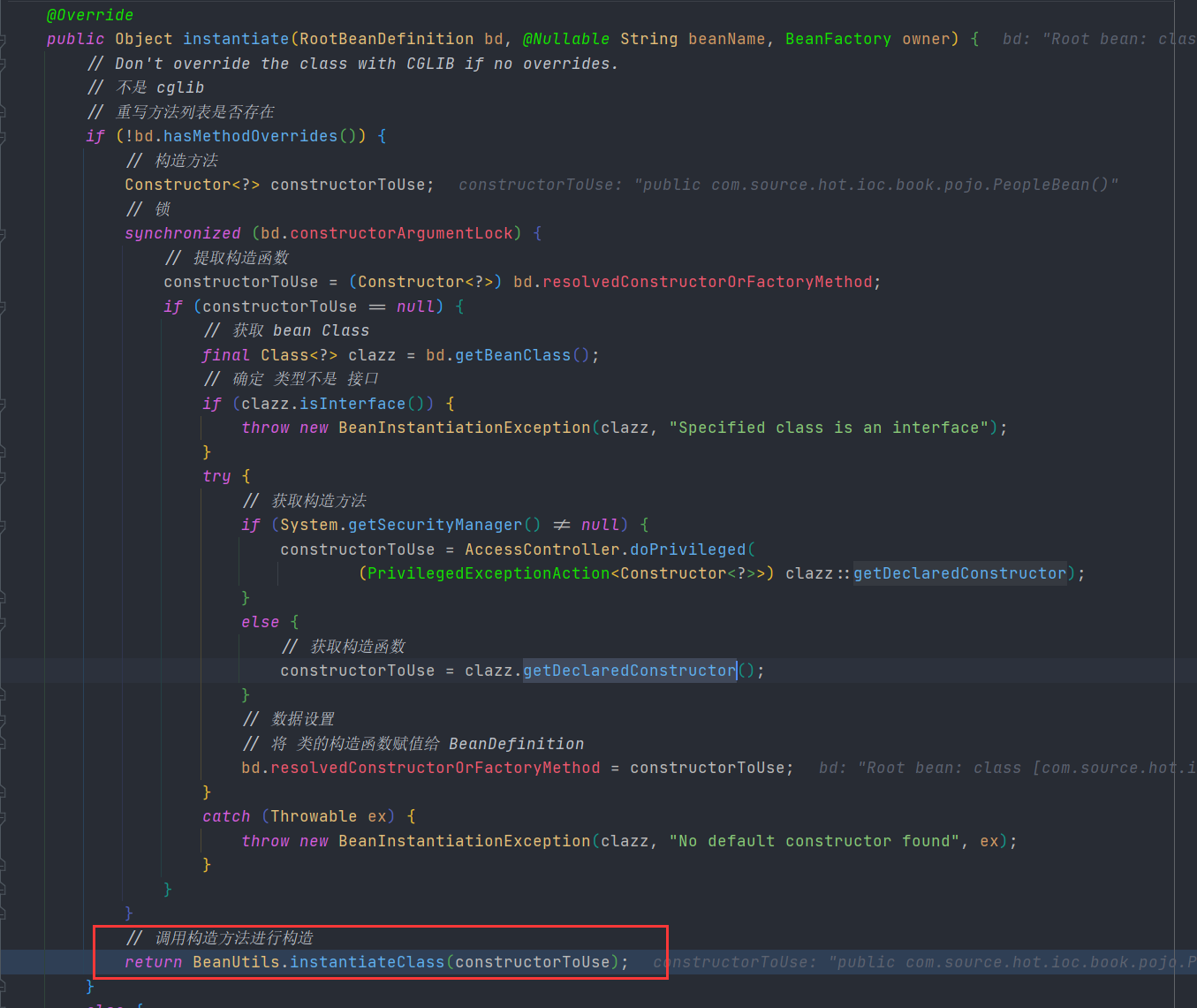本篇文章给大家分享的是有关JavaBeanInfo 和 Spring 之间有什么关系,小编觉得挺实用的,因此分享给大家学习,希望大家阅读完这篇文章后可以有所收获,话不多说,跟着小编一起来看看吧。
在 Spring 中我们可以看到 BeanInfoFactory 该接口可以用来获取 Class 对应的 BeanInfo 对象,在 CachedIntrospectionResults 中也有相关的成员变量作为信息存储,其他地方还有笔者就不再这里都去搜索了,各位可以自行查阅。
BeanInfoFactory
public interface BeanInfoFactory {
@Nullable
BeanInfo getBeanInfo(Class<?> beanClass) throws IntrospectionException;
}CachedIntrospectionResults
public final class CachedIntrospectionResults {
private final BeanInfo beanInfo;
}对于 Spring 来说操作 Bean 本身的内容其实是操作各类属性及其提供的方法。从笔者的角度来看 Bean 这个对象我觉得可以分成这三种,第一种是关于 Bean 属性的,第二种是关于属性操作的方法,第三种是提供外部操作的方法。就比如说现在有一个 People 对象,存在多个属性,我们在对这个 Bean 对象定义的时候正常情况下我们会放入 private 修饰的属性名,然后在提供 get 和 set 方法,如果有需要我们可以在通过非属性操作相关的方法。本章就暂时是对前两者的一个讨论。
首先我们来定义一个基本的 Java Bean
public class Student {
private String name;
public String getName() {
return name;
}
public void setName(String name) {
this.name = name;
}
}现在我们用了一个名字叫做 Student 的 Java 对象,我们来看这个对象的解释
在 Student 对象中具有属性 name
在 Student 对象中存在字段 name
我们通常情况下会有这两种对象的定义解释,那么这个定义解释在 Java 中是如何对其进行定义的呢。在 Java 中有一个接口叫做 java.beans.BeanInfo 这个接口是用来描述 Java Bean 的接口,下面我们来看这个接口中存在的方法
BeanInfo 方法信息
public interface BeanInfo {
BeanDescriptor getBeanDescriptor();
EventSetDescriptor[] getEventSetDescriptors();
int getDefaultEventIndex();
PropertyDescriptor[] getPropertyDescriptors();
int getDefaultPropertyIndex();
MethodDescriptor[] getMethodDescriptors();
BeanInfo[] getAdditionalBeanInfo();
}getBeanDescriptor :返回 Bean 的描述信息
getEventSetDescriptors:返回 Bean 相关的事件信息
getDefaultEventIndex:返回 Bean 默认事件索引
getPropertyDescriptors:返回 Bean 属性描述
getDefaultPropertyIndex:返回 Bean 默认的属性索引
getMethodDescriptors:返回 Bean 方法描述
getAdditionalBeanInfo :返回其他的 Bean Info 信息
下面我们先来对接口中的返回值做一些介绍
BeanDescriptor 成员变量表
| 变量名称 | 变量类型 | 变量说明 |
|---|---|---|
beanClassRef | Reference<? extends Class<?>> | bean 的类 |
customizerClassRef | Reference<? extends Class<?>> | 自定义的类 |
PropertyDescriptor 成员变量表
| 变量名称 | 变量类型 | 变量说明 |
|---|---|---|
propertyTypeRef | Reference<? extends Class<?>> | 属性类型 |
readMethodRef | MethodRef | 读方法 |
writeMethodRef | MethodRef | 写方法 |
propertyEditorClassRef | Reference<? extends Class<?>> | 属性编辑类型 |
bound | boolean | |
constrained | boolean | |
baseName | String | |
writeMethodName | String | 写方法名称 |
readMethodName | String | 读方法名称 |
MethodDescriptor 成员变量表
| 变量名称 | 变量类型 | 变量说明 |
|---|---|---|
methodRef | MethodRef | 方法 |
paramNames | String[] | 参数名称 |
params | List<WeakReference<Class<?>>> | 参数信息 |
parameterDescriptors | ParameterDescriptor | 参数描述 |
在了解了上述三个对象后我们来编写一个测试用例,该测试用例主要用来获取 BeanInfo 接口数据
BeanInfo 测试用例
@Test
void classTest() throws IntrospectionException {
Class clazz = Student.class;
BeanInfo beanInfo = Introspector.getBeanInfo(clazz);
System.out.println();
}BeanInfo 信息

我们现在对 BeanInfo 有了一定的了解,接下来我们要通过 BeanInfo 来创建一个对象,并给该对象进行数据赋值,下面我们来写代码
@NotNull
private <T> T getObject(Class<T> clazz, Map<String, Object> prop) throws Exception {
// 获取 BeanInfo 接口
BeanInfo beanInfo = Introspector.getBeanInfo(clazz);
// 获取 Bean Class
Class<?> beanClass = beanInfo.getBeanDescriptor().getBeanClass();
// 获取所有的构造函数
Constructor<?>[] declaredConstructors = beanClass.getDeclaredConstructors();
// 确认构造函数: 直接取无参构造
Constructor constructor = confirmConstructor(declaredConstructors);
// 通过构造函数获取对象
Object bean = constructor.newInstance();
// 为对象设置属性
// 提取属性描述
PropertyDescriptor[] propertyDescriptors = beanInfo.getPropertyDescriptors();
for (PropertyDescriptor propertyDescriptor : propertyDescriptors) {
// 属性名称
String name = propertyDescriptor.getName();
if (prop.containsKey(name)) {
// 写函数
Method writeMethod = propertyDescriptor.getWriteMethod();
// 从属性表中获取属性名称对应的属性值
Object proValue = prop.get(name);
writeMethod.invoke(bean, proValue);
}
}
return (T) bean;
}编写这段代码的主要逻辑如下
通过 Class 获取 BeanInfo 接口
通过 BeanInfo 获取 beanClass
通过 beanClass 提取构造函数列表,从构造函数列表中选择一个具体的构造函数(这里采用无参构造的方式)
获取属性描述对象进行属性设置
编写完成后我们来写测试用例
@Test
void beanInfoCreateBean() throws Exception {
Class<Student> clazz = Student.class;
// 设置属性表
Map<String, Object> prop = new HashMap<>(8);
prop.put("name", "student_name");
Student bean = getObject(clazz, prop);
assert bean.getName().equals("student_name");
}这样我们就完成了数据赋值,在上述过程中我们对于 beanClass 的获取可以直接使用参数传递的 clazz 直接使用,可以不需要通过 BeanInfo 接口进行二次调度。
下面我们来谈一谈 Spring 和 BeanInfo 的一些关联。
相信各位在使用 Spring XML 模式的时候会编写下面这样的内容。
<bean id="people" class="com.source.hot.ioc.book.pojo.PeopleBean">
<property name="name" value="zhangsan"/>
</bean>这里我们抛开 Spring 中 Bean 生命周期相关的一些接口、占位符解析等内容,我们就简单的来看这个 <bean> 标签,这个标签定义了一个 class 属性 和子标签 property ,我们可以通过一些 XML 解析工具得到这两个对象,Spring 在这会将 class 属性通过 ClassLoader 转换成 Class 会将 property 转换成对象 PropertyValue ,然后通过反射将对象创建出来。那么这段说明和我们所编写的通过 BeanInfo 创建 Bean 有什么关系呢?我们可以思考下面几个问题
知道了 BeanClass 如何才能创建对象呢?
知道属性名称和属性值如何给对象赋值呢?
这两个问题的答案很简单就是通过 Java 反射机制来进行处理,那么具体怎么做呢?这个问题的答案其实就是我们前面所编写的那段创建对象的代码。回过头我们来看这两个问题
第一个问题的答案:创建对象其本质是寻找构造函数并调用
第二个问题的答案:通过找到写方法将数据写入
Spring 中无参构造函数的调用

有参构造的推论过程

在这里做出了两种构造函数的推论,当完成推论构造函数后就可以进行对象创建及属性赋值了。
属性赋值相关的代码就不在截图了各位可以自行查找。
当我们有了 getObject 这样一个方法后,我们再来看一些生命周期,Spring 当中的各类生命周期其实就是围绕者这段代码的前后来做各种补充操作,
比如 InitializingBean 这个接口的调用时在 Bean 创建完成后,那么我们可以在具体的位置上补充这样一段
修改后的 getObject
@NotNull
private <T> T getObject(Class<T> clazz, Map<String, Object> prop) throws Exception {
// 获取 BeanInfo 接口
BeanInfo beanInfo = Introspector.getBeanInfo(clazz);
// 获取 Bean Class
Class<?> beanClass = beanInfo.getBeanDescriptor().getBeanClass();
// 获取所有的构造函数
Constructor<?>[] declaredConstructors = beanClass.getDeclaredConstructors();
// 确认构造函数: 直接取无参构造
Constructor constructor = confirmConstructor(declaredConstructors);
// 通过构造函数获取对象
Object bean = constructor.newInstance();
// 为对象设置属性
// 提取属性描述
PropertyDescriptor[] propertyDescriptors = beanInfo.getPropertyDescriptors();
for (PropertyDescriptor propertyDescriptor : propertyDescriptors) {
// 属性名称
String name = propertyDescriptor.getName();
if (prop.containsKey(name)) {
// 写函数
Method writeMethod = propertyDescriptor.getWriteMethod();
// 从属性表中获取属性名称对应的属性值
Object proValue = prop.get(name);
writeMethod.invoke(bean, proValue);
}
}
if (bean instanceof InitializingBean) {
((InitializingBean) bean).afterPropertiesSet();
}
return (T) bean;
}以上就是JavaBeanInfo 和 Spring 之间有什么关系,小编相信有部分知识点可能是我们日常工作会见到或用到的。希望你能通过这篇文章学到更多知识。更多详情敬请关注亿速云行业资讯频道。
亿速云「云服务器」,即开即用、新一代英特尔至强铂金CPU、三副本存储NVMe SSD云盘,价格低至29元/月。点击查看>>
免责声明:本站发布的内容(图片、视频和文字)以原创、转载和分享为主,文章观点不代表本网站立场,如果涉及侵权请联系站长邮箱:is@yisu.com进行举报,并提供相关证据,一经查实,将立刻删除涉嫌侵权内容。
原文链接:https://my.oschina.net/huifer/blog/4953589